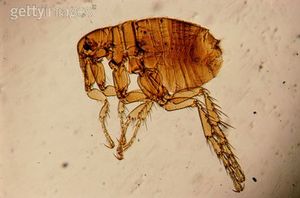Flea and tick season is nipping at the heals of summer-time. Is you your dog suffering from fleas and ticks? Does he continually bite and gnaw himself to itch the flea bites? Before heading out to the pet store for a chemical flea treatment, try these natural options for flea and tick prevention.
Chemical based flea and tick preventatives are a concern for the environment, and the safety of your pet. Flea collars are one of the most common flea preventatives on the market today. Since the product is worn on the neck and designed to absorb a chemical through your dog’s skin, it is inevitable that the dog will also inhale the product, which can make him sick.
If you notice your pet acting dizzy, lethargic or nauseated after applying any commercial brand flea & tick preventative, discontinue use of the product, quickly wash it off the animal if possible and see your veterinarian immediately. Be sure to take the product packaging to the veterinarian’s office so they can see what products(s) may be poisoning or causing allergic reactions in your pet.
When preventing fleas, you need to think of flea prevention not only for the pet, but also for the areas where he lives, including your yard.
Repelling fleas & ticks in your yard
Cedar is a natural repellent for fleas and ticks. When landscaping your yard, try using cedar based mulch. If you dog is in a kennel style enclosure, try making a perimeter of mulch around his enclosure as a barrier for the fleas.
You can also try planting Tansy around the dog kennel enclosure, out of reach of the dog. This low toxicity plant has a fern-like appearance and is normally not consumed by pets, but since it does have a low level of toxins, it is best to keep your pet away from the plant. Tansy is a natural flea repellent.
Repelling fleas & ticks on your pet
Make a daily visual check of your pet. Look on his tummy, under his arms, behind the ears, near his mouth and anus. If you see little specks of black, you may be seeing flea waste, or a flea itself. The fleas can be black or red if they have fed recently. Use a flea comb to go through your dog’s fur in areas where you can’t see his skin. If you flea comb looks “peppered” your pet probably has fleas.
To make a homemade flea spray, thinly slice a lemon or lime, and put it into two cups of water. Bring the mixture to a boil, and then let it sit and steep. Allow it to cool overnight. In the morning, put it into a spray bottle and use it on your pet as a flea repellent. Be sure to spray behind the ears, in the armpits and around the base of the tail. Avoid the pet’s eyes. This preventative should last at least a half a day. Reapply as needed.
Another simple flea spray is a mixture of one cup of water with a few drops of eucalyptus essential oil and lemon essential oil.
Making a homemade flea collar is also a safe way to prevent fleas on your pet. Sprinkle a rope or cloth collar or bandana with eucalyptus essential oil, lavender essential oil, tea tree essential oil, citronella essential oil or geranium essential oil. Be sure to re-apply the oils to the collar at least once a week.
You can also feed your dog a few natural items to help repel the fleas. When eaten, these items will be excreted though your dog’s skin, making him less than tasty to fleas.
Add one teaspoon of natural apple cider vinegar to your pet’s water bowl. The acidic vinegar will be excreted though the dogs skin, warding off fleas.
Try adding brewer’s yeast to your dogs daily food rations. One teaspoon per 30 pounds of dog weight is recommended. You can find Brewer’s yeast tablets at your local pet store, or health food store. Be sure not to use baking yeast.
Repelling fleas & ticks in your home
Regular house cleaning is essential to minimize fleas.
Vacuuming every 2-3 days is mandatory with pets. Try sprinkling Borax (laundry detergent) on your carpets and let it sit for 24-48 hours before vacuuming. This will help kill the fleas, eggs and larvae. Repeat the Borax treatment every 2-3 weeks.
Washing bedding, pillows, blankets, sofa covers and rugs in a hot water wash will also help end the flea cycle. By adding eucalyptus oil to the final rinse cycle of your wash, you can also eliminate most dust mite.
***NOTE: These recommendations are for dogs only. Do not use these remedies on cats. Many types of essential oils are toxic to cats.***
The Dollar Stretcher, “Natural Flea Prevention.” The Dollar Stretcher: Living Better For Less
URL: (http://www.stretcher.com/stories/01/010305a.cfm)
Dr. Michael W. Fox, “Preventing Fleas, Ticks and Mosquitos.” Dr. Michael W. Fox
URL: (http://tedeboy.tripod.com/drmichaelwfox/id35.html)
Frances Gavin, “Farewell to Fleas.” Dog Tricks, Tips and Insights
URL: (http://www.lacetoleather.com/safefleacure.html)




